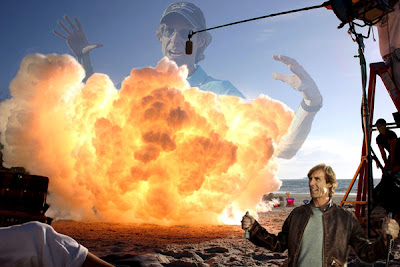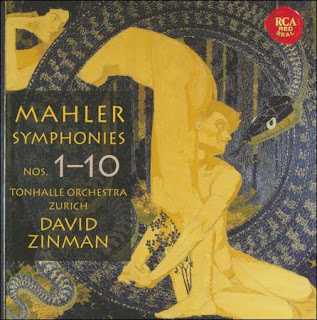Selma Jezková bows at Lincoln Center Festival
Friday night at the Rose Theater featured the U.S. premiere of Selma Jezková, a new opera by contemporary composer Poul Ruders. Based on the Lars von Trier film Dancer in the Dark, this is a lean, powerful one-act opera that condenses its grim source material into a parable greed, grief and fear.
Mr. Ruders' opera owes some debt to Alban Berg's Wozzeck and Leoš Janáček's Kat'a Kabanova, works that illustrate the grim reality of ordinary people suffering in circumstances beyond their control. In this case, the victim is Selma, (soprano Ylva Kihlberg) a Czech factory worker struggling with hereditary blindness, and saving money for an operation for her son Gene, so he will not suffer the same fate.
Mounted on a unit set and told as a flashback from Selma's funeral, the opera opened with a tableau of heart-breaking power. Before the orchestra starts, Selma lay in a coffin in a burned-out church filled with candles. Her son Gene Carl Philip Levin) approached the coffin and slowly lifted his mother out, with infinite tenderness. Then the music started, and Selma rose slowly from her resting-place for one last rapproachment with her son, to try to make him understand where she had gone wrong and to apologize for her mistakes.
The music is written in a flexible idiom, drawing together atonality, bitonality and minimalist ideas to create a tightly woven carpet of sound. The score made some unusual choices: grim, atonal chords for piano, tuba, and bass saxophone, alternating with joyful melodies derived from the musicals that are the only illumination in Selma's rapidly darkening world. In its later pages, Mr. Ruders opens major-chord progressions, as Selma resigns herself to the hangman's noose in her effort to save Gene's eyesight. The final scene is simple, yet devastating in its impact.
Ms. Kihlberg was a magnetic, heart-tugging presence in the title role, a character created for the film by Icelandic singer Björk. Under Michael Schønwandt's skilled baton, Ms. Kihlberg seduced the listener, leading the audience in Selma's downward spiral. The long, arching phrases sung by her character recall the writing of Richard Strauss, and the sheer animal panic as she is marched to the scaffold recalled the frantic fate of a certain Puccini heroine. This was a devastating performance combined with difficult physical acting, particularly in the heart-stopping stunt of Selma's execution.
The tightly constructed production by Kasper Holten made use of a unit set, as the dark church transformed into a factory, a tenement, and a courtroom, the whole in blacks and sepias suited to the grim tone. A projected stained glass window toward the back gave no color, and eventually transformed into a blinking, searching eye--either a metaphor for the crushing wheels of justice or for the onset of Selma's blindness.
This dark world was populated with a strong supporting cast. Tenor Gert Hennings-Jensen brought a peacock strut to the role of the district attorney, recalling another nightmarish prosecutor in Pink Floyd's The Wall. Not surprisingly, he doubled as the executioner. Baritone Palle Knudsen was the picture of venality as Bill, (Selma's landlord) who is the willing, complicit victim in his own murder. Mezzo-soprano Hanne Fischer cut a sympathetic figure as Kathy, a co-worker at the textile plant. And Mr. Levin stayed onstage throughout, a mute witness to his mother's tragedy who was only heard from when it was too late.
 |
| Ylva Kihlberg (right) sings the title role in Selma Jezková. Photo by Miklos Szabo. |
Mr. Ruders' opera owes some debt to Alban Berg's Wozzeck and Leoš Janáček's Kat'a Kabanova, works that illustrate the grim reality of ordinary people suffering in circumstances beyond their control. In this case, the victim is Selma, (soprano Ylva Kihlberg) a Czech factory worker struggling with hereditary blindness, and saving money for an operation for her son Gene, so he will not suffer the same fate.
Mounted on a unit set and told as a flashback from Selma's funeral, the opera opened with a tableau of heart-breaking power. Before the orchestra starts, Selma lay in a coffin in a burned-out church filled with candles. Her son Gene Carl Philip Levin) approached the coffin and slowly lifted his mother out, with infinite tenderness. Then the music started, and Selma rose slowly from her resting-place for one last rapproachment with her son, to try to make him understand where she had gone wrong and to apologize for her mistakes.
The music is written in a flexible idiom, drawing together atonality, bitonality and minimalist ideas to create a tightly woven carpet of sound. The score made some unusual choices: grim, atonal chords for piano, tuba, and bass saxophone, alternating with joyful melodies derived from the musicals that are the only illumination in Selma's rapidly darkening world. In its later pages, Mr. Ruders opens major-chord progressions, as Selma resigns herself to the hangman's noose in her effort to save Gene's eyesight. The final scene is simple, yet devastating in its impact.
Ms. Kihlberg was a magnetic, heart-tugging presence in the title role, a character created for the film by Icelandic singer Björk. Under Michael Schønwandt's skilled baton, Ms. Kihlberg seduced the listener, leading the audience in Selma's downward spiral. The long, arching phrases sung by her character recall the writing of Richard Strauss, and the sheer animal panic as she is marched to the scaffold recalled the frantic fate of a certain Puccini heroine. This was a devastating performance combined with difficult physical acting, particularly in the heart-stopping stunt of Selma's execution.
The tightly constructed production by Kasper Holten made use of a unit set, as the dark church transformed into a factory, a tenement, and a courtroom, the whole in blacks and sepias suited to the grim tone. A projected stained glass window toward the back gave no color, and eventually transformed into a blinking, searching eye--either a metaphor for the crushing wheels of justice or for the onset of Selma's blindness.
This dark world was populated with a strong supporting cast. Tenor Gert Hennings-Jensen brought a peacock strut to the role of the district attorney, recalling another nightmarish prosecutor in Pink Floyd's The Wall. Not surprisingly, he doubled as the executioner. Baritone Palle Knudsen was the picture of venality as Bill, (Selma's landlord) who is the willing, complicit victim in his own murder. Mezzo-soprano Hanne Fischer cut a sympathetic figure as Kathy, a co-worker at the textile plant. And Mr. Levin stayed onstage throughout, a mute witness to his mother's tragedy who was only heard from when it was too late.





























